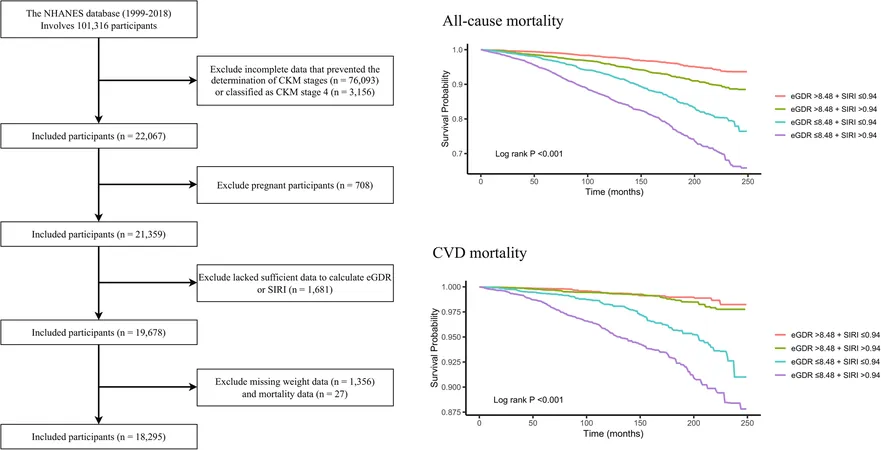
Groundbreaking Study Reveals Key Indicators of Mortality in Cardiovascular-Kidney-Metabolic Syndrome: Are You Affected?
2025-03-29
Author: Rajesh
Background
The Cardiovascular-Kidney-Metabolic (CKM) syndrome sheds light on the interwoven nature of metabolic disorders, chronic kidney disease, and cardiovascular issues. With a growing epidemic of insulin resistance (IR) and systemic inflammation contributing to CKM's progression, understanding these dynamics in early-stage patients (stages 0-3) is crucial for better health outcomes.
Study Overview
In a monumental study utilizing data from the National Health and Nutrition Examination Survey (NHANES), researchers delved into a sample of 18,295 individuals diagnosed with CKM syndrome between 1999 and 2018. The study aimed to determine how the estimated glucose disposal rate (eGDR) and the Systemic Inflammation Response Index (SIRI) correlate with all-cause mortality, particularly from cardiovascular disease (CVD).
Key Findings
Throughout an impressive follow-up period averaging 121 months, the study identified 1,998 total deaths, with 539 being cardiovascular-related. The results were telling: both eGDR and SIRI emerged as significant, independent predictors of mortality. For each unit increase in eGDR, the hazard ratios (HR) indicated a reduction in mortality risk, while elevated SIRI levels were associated with a higher mortality risk.
- eGDR: - HR for all-cause mortality: 0.90 - HR for CVD mortality: 0.85 - SIRI: - HR for all-cause mortality: 1.16 - HR for CVD mortality: 1.33
Notably, individuals exhibiting low eGDR levels coupled with high SIRI faced nearly double the risk for all-cause mortality (HR 1.97) and significantly elevated CVD mortality risks (HR 2.35). These findings were particularly pronounced in patients younger than 60, suggesting that this age group may be more vulnerable to the interplay of IR and inflammation.
Clinical Implications
The findings emphasize the importance of integrating eGDR and SIRI into regular health assessments for individuals showing early signs of CKM syndrome. By identifying those at heightened risk, health practitioners can implement preventive strategies and timely interventions aimed at curbing the risks of serious health outcomes.
Understanding CKM Syndrome
The CKM syndrome encompasses a wide array of risks, underscoring the complexity of health challenges faced by affected individuals. Alarmingly, studies between 2015 and 2020 showed that over 25% of American adults are impacted by this syndrome, making it one of the leading causes of mortality.
The Takeaway
Given the alarming statistics and impacts of CKM syndrome, the ongoing analysis of eGDR and SIRI presents a vital opportunity for early diagnosis and treatment. Patients and healthcare providers alike should recognize the potential benefits of monitoring these markers to navigate the often perilous landscape of cardiovascular and metabolic health.
Don’t wait! If you or someone you know may be at risk, consider a health evaluation today to stay ahead of CKM syndrome. This could be a life-saving decision!




 Brasil (PT)
Brasil (PT)
 Canada (EN)
Canada (EN)
 Chile (ES)
Chile (ES)
 Česko (CS)
Česko (CS)
 대한민국 (KO)
대한민국 (KO)
 España (ES)
España (ES)
 France (FR)
France (FR)
 Hong Kong (EN)
Hong Kong (EN)
 Italia (IT)
Italia (IT)
 日本 (JA)
日本 (JA)
 Magyarország (HU)
Magyarország (HU)
 Norge (NO)
Norge (NO)
 Polska (PL)
Polska (PL)
 Schweiz (DE)
Schweiz (DE)
 Singapore (EN)
Singapore (EN)
 Sverige (SV)
Sverige (SV)
 Suomi (FI)
Suomi (FI)
 Türkiye (TR)
Türkiye (TR)
 الإمارات العربية المتحدة (AR)
الإمارات العربية المتحدة (AR)